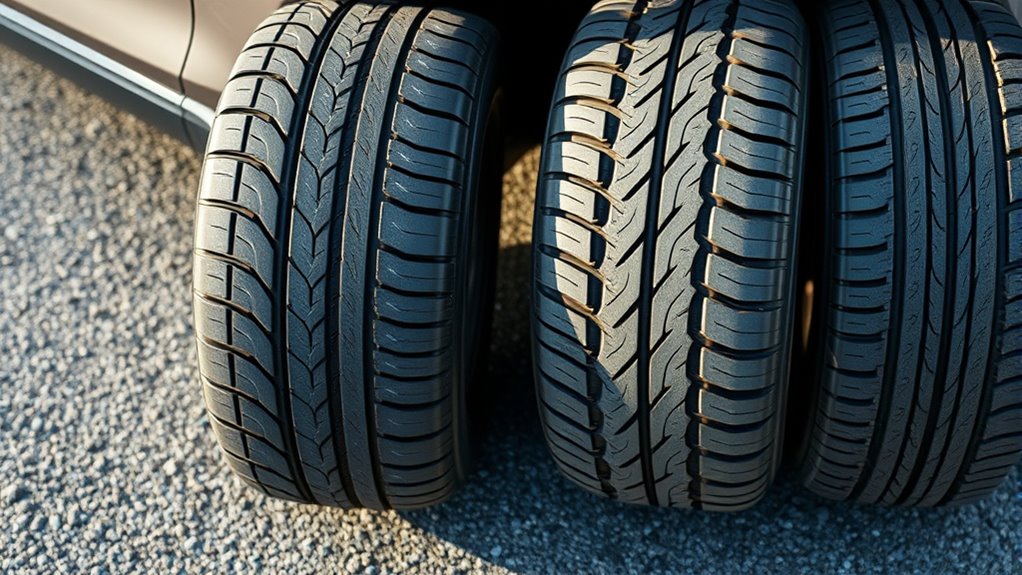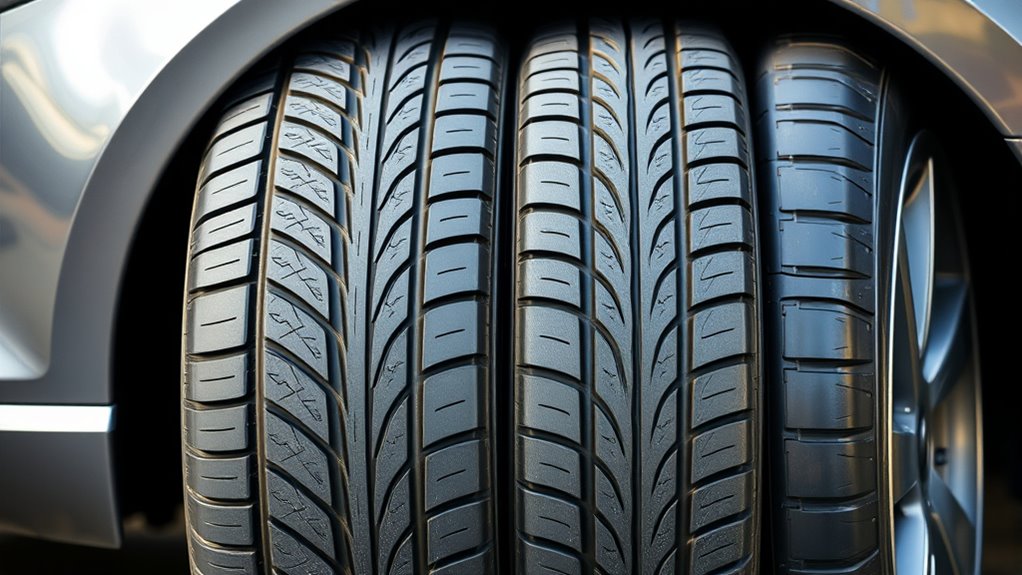To keep your tires wearing evenly, follow the recommended rotation patterns for your vehicle—most use front-to-back or crisscross methods. It’s best to rotate every 5,000 to 8,000 miles, but always check your owner’s manual for specifics. Proper timing and pattern help extend tire life, improve safety, and maintain handling. Staying consistent with these practices ensures your tires perform at their best, and you’ll find out how to choose the right pattern for your vehicle as you continue.
Key Takeaways
- Follow the vehicle manufacturer’s recommended interval, typically every 5,000 to 8,000 miles, for effective tire rotation.
- Use common rotation patterns like front-to-back or crisscross for most passenger vehicles.
- For all-wheel-drive or trucks, adhere to specific rotation procedures to prevent drivetrain issues.
- Regularly inspect tires for uneven wear patterns to identify underlying alignment or pressure problems.
- Combine tire rotation with proper inflation and alignment checks for optimal tire lifespan and safety.

Have you ever wondered why tire rotation is vital for your vehicle’s performance and safety? It’s because over time, your tires develop wear patterns that can affect handling, traction, and even fuel efficiency. Without proper rotation, some tires will wear faster or unevenly, leading to a shorter lifespan and increased risk of blowouts or accidents. That’s why understanding the right rotation intervals and pattern is essential. Typically, manufacturers recommend rotating your tires every 5,000 to 8,000 miles, but it’s always best to check your owner’s manual for specific guidance. Sticking to these intervals helps guarantee even wear and prolongs tire life, saving you money in the long run. Tire wear patterns can also vary depending on driving habits and vehicle maintenance.
Regular tire rotation ensures even wear, extends lifespan, and enhances vehicle safety and performance.
When you look at your tires, you might notice different wear patterns—feathering, cupping, or inner/outer edge wear—that indicate uneven pressure distribution or alignment issues. These patterns aren’t just cosmetic; they reveal underlying problems that can affect your vehicle’s safety and driving comfort. Regular rotation helps correct or prevent these issues by redistributing the wear across all four tires, ensuring each tire wears evenly. This process reduces the risk of premature tire replacement and maintains peak traction, especially in challenging driving conditions. If you ignore these wear patterns and neglect rotation, you could end up with tires that don’t grip the road properly or wear out prematurely, increasing your chances of accidents or costly repairs.
The key to effective tire rotation is following a proper rotation pattern suited to your vehicle type. For example, most passenger cars follow a front-to-back or crisscross pattern, but trucks or all-wheel-drive vehicles might require different approaches to avoid disturbing the drivetrain or transfer case. When you rotate your tires, you’re not just flipping them around—you’re actively balancing the wear, which helps prevent uneven tread depth that can compromise safety. It’s also a good idea to regularly inspect your tires for signs of irregular wear, and if you notice any, get them checked promptly. Combining regular rotations with proper inflation and alignment checks will maximize your tires’ lifespan and keep your vehicle running smoothly.
In essence, understanding your vehicle’s wear patterns and sticking to recommended rotation intervals isn’t just about preserving your tires; it’s about ensuring your safety and maintaining peak performance. When you make tire rotation a routine part of your vehicle maintenance, you’re actively caring for your investment and driving with confidence, knowing your tires are in the best shape possible.
Frequently Asked Questions
How Does Tire Rotation Affect Vehicle Handling?
Tire rotation improves your vehicle’s handling by promoting even tire tread wear, which guarantees better grip and stability. When you rotate tires regularly, you also help maintain proper alignment correction, preventing uneven wear that could affect steering response. This proactive approach keeps your car responsive and safe, especially during turns or sudden stops. Ultimately, consistent tire rotation helps you enjoy smoother, more predictable handling and extends the lifespan of your tires.
Are There Specific Tire Rotation Patterns for All-Wheel Drive Vehicles?
Yes, all-wheel drive vehicles often require specific tire rotation patterns to address unique tire wear patterns. Since all-wheel drive distributes power to all four wheels, you should rotate tires in a cross pattern or front-to-back, ensuring even tire wear. This helps prevent uneven wear, maintains traction, and extends tire life. Regularly rotating your tires according to these patterns keeps your all-wheel drive vehicle handling smoothly and safely.
What Are Signs Indicating It’s Time for a Tire Rotation?
Imagine you’re in a vintage arcade game—your tires are showing signs of wear. You’ll notice uneven tire wear on certain spots or tire tread wear that’s inconsistent across all tires. These signs indicate it’s time for a tire rotation. Regular rotation helps prevent uneven wear, extends tire life, and ensures safe driving. If you spot these issues, don’t delay—get your tires rotated to keep your vehicle in top shape.
How Does Tire Rotation Impact Tire Warranty Coverage?
Tire rotation can positively impact your tire warranty by helping you maintain proper tire wear, which is often a requirement for coverage. If you follow the manufacturer’s recommended rotation schedule, you’re more likely to stay within coverage limitations and avoid voiding your tire warranty. Keep records of your rotations, as they prove you’ve maintained proper care, ensuring you get the full benefits of your tire warranty if issues arise.
Can Tire Rotation Improve Fuel Efficiency?
Think of your tires as a team running a race, each with a different pace. Regular rotation keeps tire wear even, ensuring all tires perform their best. This balance reduces resistance and helps your engine work less, improving fuel economy. So, yes, by maintaining even tire wear, tire rotation can help you save fuel, making each mile smoother and more efficient, just like a well-coordinated team crossing the finish line.
Conclusion
By following the right tire rotation pattern and timing, you’ll keep your tires wearing evenly and extend their lifespan. Think of it as giving your tires a well-deserved spa day—revitalizing their performance and saving you money in the long run. Don’t wait until you’re stranded or facing costly repairs; stay proactive. With just a little effort, you’ll ensure your vehicle runs smoothly, making every mile feel like gliding on a cloud instead of bouncing over rough terrain.









